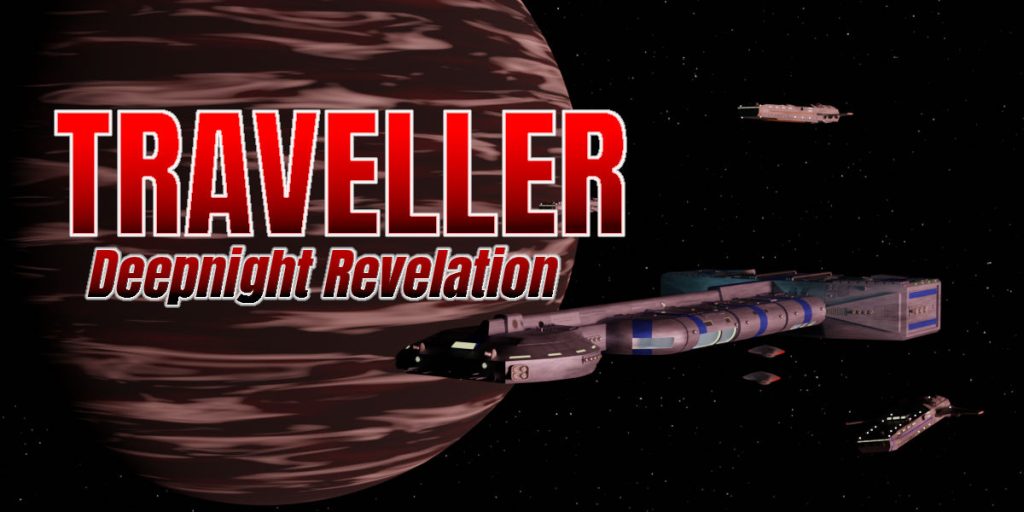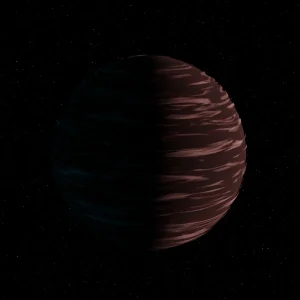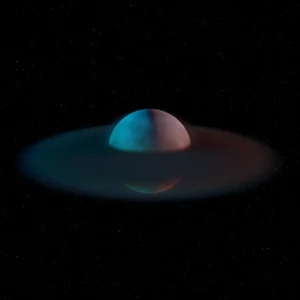Something Burrowed

The Deepnight Revelation is only 2 parsecs from Terminus, their final destination. The plan from the previous session was to send out four of the scout ships to Terminus, have them perform a quick scan, then jump back with information on what’s there.
So the four scouts are sent out. It’ll be a week to jump out, a couple of days of scanning, and then another week for them to return. During this time, the Deepnight and the three Solomani vessels take the time to perform detailed engineering checks of the ships, to ensure that they are ready for any potential fights, and also to fix anything that can be fixed.
As part of this, I wanted to provide a small status report for the players, to give them an idea of how worn down their ships were, and the chances of getting back home. The Deepnight campaign does have a very specific way of tracking wear and tear on the ship, but I gave up using that pretty quickly. It was a lot of effort to track, and also seemed quite severe in the results. So I’ve been running it as I see fit. For the status report, I just came up with some random failure chances. I wanted them to be high enough to be something to worry about, but not so high that everything seemed pointless.
Deepnight Fleet Status Report
Deepnight Revelation
The Deepnight Revelation has been in space for 14 years, and is well past its Operational Life. It has had a couple of major pieces of work done on it at starports, but the technological levels of those starports were well below that required for a vessel of this type.
It is expected that the journey back home will take in the order of another ten years.
Vessels of this class are expected to survive a few centuries, but this assumes regular high quality maintenance.
Core Structure
The core structure of the ship is beginning to show signs of weakness. Micro cracks along the central spine cannot be repaired with available tools.
Chance of failure in next 10 years: 7%
Drive Systems
The Jump Drive is the system most likely to fail in the journey home. Normally, engineering would recommend a complete replacement, but given the circumstances that isn’t possible.
Reducing jumps to 3, or even 2, parsecs may greatly improve the lifetime of the drive. However, further investigation is needed to determine whether the extended trip time (and number of jumps) this would result in would cancel out any benefits.
Chance of failure in next 10 years: 19%
Frank Wild
The Frank Wild is a Tenzig class exploration vessel. It’s designed for long voyages of exploration, though not quite to the extent that this tour has pushed it.
Core Structure
The backbone of the ship has suffered several episodes of severe stress during unclean exits from jump space. This has lead to significant fractures throughout the enterior of the ship.
Chance of failure in next 10 years: 35%
Drive Systems
The Drive system is badly damaged from too many high frequency jumps. The ability of the drive system to maintain sufficient stability during the formation of a jump bubble for more than 20 jumps is unlikely.
Chance of failure in next 10 years: 99%
Angtharkay
The Angtharkay is a Tenzig class exploration vessel. It’s designed for long voyages of exploration, though not quite to the extent that this tour has pushed it.
Core Structure
The Angtharkay’s core structure is in good condition, though the exterior hull took some damage early on in the mission from over eager pirates.
Chance of failure in next 10 years: 15%
Drive Systems
The main drive system is suffering from accuracy issues, which are getting worse over time. The full refit is recommended at this point, though keeping jumps to J-3 would help.
Chance of failure in next 10 years: 17%
Power Systems
The main fusion reactor is suffering from microcracks in the main containment vessel.
Chain of failure in next 10 years: 11%
Leonard Hussey
The Leonard Hussey is a Tenzig class exploration vessel. It’s designed for long voyages of exploration, though not quite to the extent that this tour has pushed it.
Core Structure
The Leonard Hussey is still in good condition, despite the stresses that have been put upon it.
Chance of failure in next 10 years: 7%
Drive Systems
The J-Drive is showing significant wear and tear. There are fractures in the central radiators, which could lead to overheating and deformation during a jump. Repair requires a TL-13 dockyard for a full repair.
Chance of failure in next 10 years: 12%
The players seem to take the news reasonably well, which implies that I got the numbers about right. They were concerned about the chances of getting home, and discussed possible options such as just heading back to the Federation and ‘trading in’ for a different, lower tech ship.
But that’s something to worry about later.
Back on the planet, they did their best to destroy what they could find of the Entity in the northern wastes, using some fire but mostly biological agents. They also explored the other pyramids, and destroyed any signs of infected mummies.
For the most part, their relationships with the locals was good. The locals saw them as signs of good omen, and were happy to cooperate.
After a little over a week, the first of the scout ships returned. What they provided was a map of the Terminus system.

There seemed to be two gravitational points in orbit around each other – the red star, and whatever was at the centre of the gravitic shell.
There was a habitable world, a gas giant with two clusters of trojan asteroids, an ice world, an asteroid belt and the core of a gas giant which was having its atmosphere ripped off whenever it passed close to the gravitic shell. The shell seemed to be made up of multiple point sources – naked singularities in a chaotic orbit around a centre.
I made it clear to the players that they weren’t to think too hard about the physics of the system. It’s very probably not at all stable, and just don’t ask about how the singularities work.
One of the scouts reported detecting something odd in orbit around the gas giant – maybe a spacecraft of some kind which the players assumed was the Tresskvuess. They had pushed for Alfred (their psionic Vargr, though most of the crew didn’t know he was a psion) to go aboard one of the scouts, and he reported back that he hadn’t detected anything obviously dangerous. A slight headache maybe, but not much else.
The plan is to jump into the system as one, using the main gas giant as cover from the shell. In order of importance, they decided that they should investigate the main gas giant first, followed by the habitable world, then the gas giant core, then the gravitic shell and finally the unknown stellar object.
And so, they make their jump into the system.

The Jovian world is dark, with large quantities of carbon in its atmosphere. It has several icy moons, the inner ones of which have coverings of dark matter. There are no signs of any ships here though. Refuelling from the gas giant doesn’t look like it would be healthy for the ship’s fuel filters, which are already past their warranty period. So they examine the icy worlds, whilst sending the three of the scouts out to example the trojan points and the ice world. For now, they will avoid the habitable world until they are all ready to go there.
On the outermost moon, there are large craters, or holes in the ice. Khadashi and Shiiguma head down to investigate. After playing around sliding down the ice, they discover signs of organic matter from a creature – something similar to the ‘space whales’ that they first encountered over a decade ago. However, this one showed signs of being infected by the Entity.

One of the scouts, the Far Reacher, had started its deceleration burn towards the leading set of trojan asteroids. It had picked up signs of something high tech and metallic amongst the asteroids there. It had also picked up something moving – a space whale.
And the space born creature was heading rapidly towards the scout. They had a few hours to discuss what to do, and to request permission to open fire if necessary. Permission was granted, and some jump coordinates were sent across since the scout didn’t currently have an astrogator aboard.
As the creature closed in, the scout fired a missile as a distraction, but it was ignored. Just before impact, the scout opened fire with its pulse lasers, scoring some hits. The pilot made some fancy manoeuvres, managing to twist out of the way as the creature tried to smash it with its tail. They had survived, but the creature was rapidly decelerating at over 10g, and the Scout had no chance of out running it.
So it jumped.
The creature was code named Moby Duck. It seemed confused by the sudden disappearance of the scout, but seemed to be heading back to the set of Trojan asteroids where the technological object had been detected.
Plans were sent out to the other two scouts on best tactics for use against the space whale, and the Deepnight’s Red Team began their wargaming exercises. They hadn’t planned for anything like this, and considered the whale to be a serious threat.
They also considered the object in the Trojans a point of high interest, so they may have to take on the whale as some point. They’d done their best to avoid as much space combat as possible, and now at their destination they were having to plan for some.
We are now reaching the culmination of the entire campaign, which has been going on for around four years. Not the longest campaign I’ve run, but it has been a regular weekly game. To say I’m nervous about this final part is probably an understatement. Normally I have a fairly good idea of what’s probably going to happen – or at least, what’s going to happen if the players don’t do anything completely unexpected. I don’t have that yet for this campaign.
There’s not a clear expectation of what the players will want to do. Normally if it’s a published adventure, there’s a very strong plot line that needs to be followed (kill the big bad, rescue the hostages, grab the Orb of Phanastacoria). If it’s been more of a sandbox, then the players will have their own definite agenda. This is something that’s been lacking to some extent in this campaign. The main drive has been to get to Terminus, and now that the ship is here, after four years of playing, the actual question of what to do is a bit fuzzy.
Some crew members have their own definite ideas, so I may need to have them drive some of that. So far, the players seem keen on at least investigating. But there are risks involved, and they have been very risk averse up until this point. A good trait to have in order to ensure the Deepnight survived until its destination, but it has occasionally put them off exploring. Given the need to get back home after this, they may want to minimise risk. After ~15 years of mission though, plenty of the crew won’t want to just take some pictures and then go home. Not just because some are out of revenge, but others will feel that they’ll regret it for the rest of their lives if they go home without answers.
Where did the Far Reacher jump to?